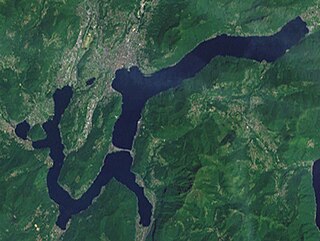
Lake Lugano is a glacial lake which is situated on the border between southern Switzerland and northern Italy. The lake, named after the city of Lugano, is situated between Lake Como and Lago Maggiore. It was cited for the first time by Gregory of Tours in 590 with the name Ceresio, a name which is said to have derived from the Latin word cerasus, meaning cherry, and refers to the abundance of cherry trees which at one time adorned the shores of the lake. The lake appears in documents in 804 under the name Laco Luanasco.
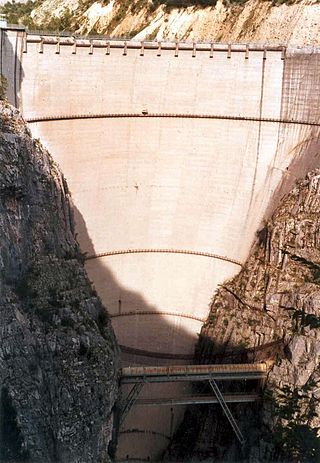
The Vajont Dam or Vaiont Dam is a disused hydro-electric dam in northern Italy. It is one of the tallest dams in the world, with a height of 262 m (860 ft). It is in the valley of the Vajont (river) under Monte Toc, in the municipality of Erto e Casso, 100 km (62 mi) north of Venice.

The Savio is a river in the Emilia-Romagna region of northern Italy. Its source is in the province of Forlì-Cesena near Montecoronaro on Mount Castelvecchio which is near the western side of Mount Fumaiolo. The source is at an elevation of 1,126 metres (3,694 ft) and is marked by an iron monument. A wolf and the rings of the caveja are on this monument. The river flows near Verghereto and Bagno di Romagna as it winds through the mountains before entering Lago di Quarto. After leaving the lake, the river flows northeast near Sarsina and Mercato Saraceno before flowing north. The river winds for 96 kilometres (60 mi) along the valley. Its natural track has been preserved relatively well and, in the territory of Cesena, it shows an environment which is one of the purest of the whole Romagna. North of Cesena, the river crosses the border into the province of Ravenna. After a total course of 126 kilometres (78 mi) the river enters the Adriatic Sea north of Cervia by Lido di Classe and Lido di Savio.

Enel S.p.A. is an Italian multinational manufacturer and distributor of electricity and gas. Enel was first established as a public body at the end of 1962, and then transformed into a limited company in 1992. In 1999, following the liberalisation of the electricity market in Italy, Enel was privatised. The Italian state, through the Ministry of Economy and Finance, is the main shareholder, with 23.6% of the share capital as of 1 April 2016.

Lago di Lei is a reservoir in the Valle di Lei, powering the Hinterrhein storage power stations. The reservoir is almost entirely in Italy, but the barrage was built on territory ceded by Italy to Switzerland in 1955 after diplomatic talks, while an equivalent sized territory further north of the lake was ceded to Italy in the exchange. The dam is operated by Kraftwerke Hinterrhein. The waters of the lake are the only waters in Italian territory that drain to the North Sea, being part of the Rhine's drainage basin. Other waters of Italy that do not flow to the Mediterranean Sea are found in the valley of Livigno, valley of Sexten, Puster Valley east of Innichen, and most of the waters of the municipality of Tarvisio east of Sella Nevea: all these waters flow to the Black Sea through the basin of the Danube.
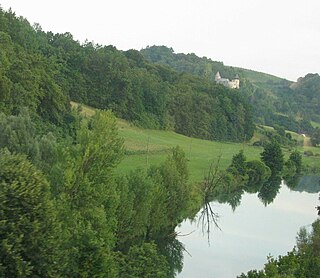
The Dobra is a river located mostly in the Karlovac County in the Republic of Croatia. It is 104.2 kilometres (64.7 mi) long and its basin covers an area of 1,428 square kilometres (551 sq mi). Its name is the feminine form of the Croatian adjective meaning "good" but it is over simplistic folk etymology. The river name probably comes from the Celtic transl. cel – transl. dubrum, dubron meaning 'water', Illyrian δυβρις 'deep' or Old Slavonic dъbrь also 'deep' or 'valley'.

The Reno is a river of Emilia-Romagna and Tuscany, northern Italy. At 211 km (131 mi), it is the tenth longest river in Italy and the most important of the region apart from the Po.

Lago Bianco is a reservoir at the Bernina Pass in the Swiss canton of Graubünden.
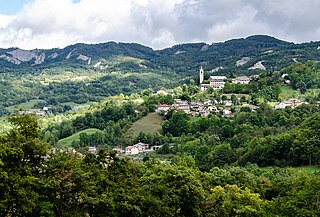
Fontanaluccia is a frazione of the comune of Frassinoro in the Province of Modena, Emilia-Romagna, central Italy.

Lago della Vacca is an artificial lake in the Caffaro Valley in the Province of Brescia, Lombardy, Italy, west of Cornone di Blumone. At an elevation of 2358 m, its surface area is 0.256 km2.
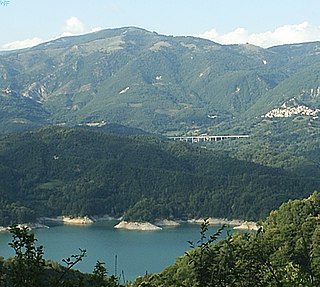
Lago del Salto is a reservoir lake in the Province of Rieti, Lazio, Italy. At an elevation of 535 m, its surface area is 10 km².

Enel Green Power S.p.A. is an Italian multinational renewable energy corporation, headquartered in Rome. The company was formed as a subsidiary of the power generation firm Enel in December 2008. It has operations in five continents generating energy from solar, geothermal, wind and hydropower sources. As of 2024, it manages a capacity of 63,8 GW, with an annual production of 75.95 TWh and has over 1300 plants worldwide.

The Metropolitan City of Bologna is a metropolitan city in the Emilia-Romagna region of Italy. Its capital is de facto the city of Bologna, though the body does not explicitly outline it. It was created by the reform of local authorities and established by the Law 56/2014, replacing the province of Bologna. It has been operative since 1 January 2015.

The Cismon is a mountain stream in northern Italy, the main tributary of the Brenta River. The torrent flows from the Dolomites mountains in the Trentino Alto-Adige region through the plains of Venetian territory to the bigger Brenta River, which in turn flows into the Adriatic Sea in the Gulf of Venice.
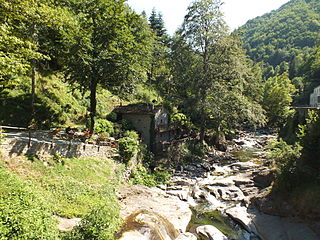
The Limentra di Sambuca is a mountain river in Italy, a right tributary of the Reno. It passes through Sambuca Pistoiese, on the north side of the Apennine Mountains. Its valley runs from southwest to northeast, parallel to the upper valley of the Reno to its west and the Limentrella to its east. It has a length of 19.4 kilometres (12.1 mi) and flows into the Reno near Ponte della Venturina, near the border between Tuscany and Emilia-Romagna.

The Limentra orientale (also: Limentra di Treppio) is a mountain river in Italy, a right tributary of the Reno. Its valley runs roughly from southwest to northeast, on the north side of the Apennine Mountains. Its upper valley is part of the Natura 2000 protected area Tre Limentre – Reno. Near Suviana is a 97 m (318 ft) high dam, creating one of the largest reservoirs of the Apennines, Lake Suviana, with a capacity of about 46,000,000 cubic metres (1.6×109 cu ft). It was built between 1928 and 1932 and is used for hydropower. The Bargi hydroelectric power station, site of a deadly explosion in April 2024, is situated at Lake Suviana. The Limentra orientale enters the Metropolitan City of Bologna near Lentula and Treppio. It flows into the Reno after 41 kilometres (25 mi), near Riola di Vergato.
The Campo Moro dams are a pair of hydroelectric-gravity dams situated in Lanzada, in the province of Sondrio, Lombardy. The two dams are called Alpe Gera dam and Campo Moro dam. Alpe Gera, the largest of the pair, was constructed with approximately 1,800,000 m3 of concrete to create the Alpe Gera reservoir. The lower dam, Campo Moro, was created to form the Campo Moro reservoir.
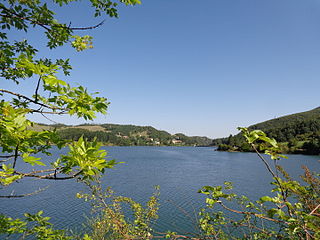
Lake Brasimone is an artificial lake located on the Bolognese Apennines along the Brasimone stream, in the municipal territory of Camugnano and is included within the Suviana and Brasimone.
The regional park of the Suviana and Brasimone lakes is a protected natural area established in 1995, consisting of two artificial lakes, Lake Suviana and Lake Brasimone, and their surrounding area. The park is located in Bolognese Apennines, in Emilia-Romagna, on the border with Tuscany. The lakes were built in 1933 and 1911, respectively, and used for the production of hydroelectricity. Inside the park are several smaller protected areas, including the abandoned village of Chiapporato, the Suviana and Brasimone Lakes protected area,.

Bargi hydroelectric power station is a hydroelectric power station in the north-central part of Italy, in the Emilia-Romagna region. The power station is located in Bargi, one of the villages around Lake Suviana lying upstream, in Camugnano near Bologna. It uses reservoirs created in the confluence of two right tributaries of the river Reno, which flows into the Adriatic Sea north of Ravenna). It is owned by Enel Green Power.


















